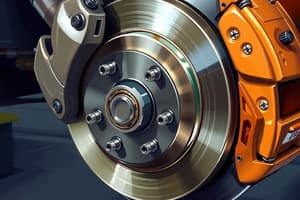Podcast
Questions and Answers
What type of brake system uses a circular disc rotator attached to the wheel hub?
What type of brake system uses a circular disc rotator attached to the wheel hub?
- Hydraulic Brakes
- Disc Brakes (correct)
- Pneumatic Brakes
- Drum Brakes
Which type of brake system is commonly found on cars, motorcycles, and bicycles?
Which type of brake system is commonly found on cars, motorcycles, and bicycles?
- Drum Brakes
- Hydraulic Brakes
- Mechanical Brakes
- Disc Brakes (correct)
What factor influences a brake system's performance by affecting how well the brakes work and how long they last?
What factor influences a brake system's performance by affecting how well the brakes work and how long they last?
- Wheel Size
- Friction Material (correct)
- Paint Color
- Weight of the Vehicle
What component of a brake system uses a pressurized fluid to amplify the stopping power?
What component of a brake system uses a pressurized fluid to amplify the stopping power?
What is the role of brake fluid in a vehicle's braking system?
What is the role of brake fluid in a vehicle's braking system?
Which component converts the force from the brake pedal into hydraulic pressure?
Which component converts the force from the brake pedal into hydraulic pressure?
What happens when the brake lines become damaged?
What happens when the brake lines become damaged?
What do brake calipers and wheel cylinders contain?
What do brake calipers and wheel cylinders contain?
In disc brake systems, what do the brake pads press against?
In disc brake systems, what do the brake pads press against?
What is the role of the brake pedal in a vehicle's braking system?
What is the role of the brake pedal in a vehicle's braking system?
Flashcards are hidden until you start studying
Study Notes
Braking Basics: Understanding Types, Performance, and Components
Brakes are an essential safety system in every vehicle, allowing us to stop or slow down with confidence. This article will explore the fascinating world of brakes, focusing on their diverse types, the factors that influence performance, and the components that make up these systems.
Types of Brakes
There are three main types of brakes that we'll discuss.
1. Disc Brakes
Disc brakes use a circular disc rotator attached to the wheel hub, and a brake caliper that clamps the brake pads against the disc. Disc brakes are commonly found on cars, motorcycles, and bicycles, offering good stopping power and resistance to heat build-up.
2. Drum Brakes
Drum brakes use a drum-shaped mechanism (the brake drum) into which the brake shoes are pressed, creating friction to slow down the wheel. Drum brakes are typically found on older vehicles and some trucks.
3. Hydraulic Brakes
Hydraulic brakes use a pressurized fluid to convert the force applied by the driver into a stronger force acting upon the brake pads, amplifying their stopping power. This design is found in both disc and drum brakes, enhancing the effectiveness of the braking system.
Performance Factors
A brake system's performance is influenced by several factors:
1. Friction Material
The friction material used in brake pads, shoes, and rotators affects how well the brakes work and how long they last.
2. Brake Fluid
Brake fluid plays a crucial role in transferring the force from the brake pedal to the brake components. High-quality brake fluid ensures better performance and longer service life.
3. Brake Line Condition
Brake lines can become damaged, causing a drop in performance. Regular inspections and replacement when necessary are vital to maintain safe braking.
Key Components
The brake system consists of several components, each playing a vital role in its operation.
1. Brake Pedal
The brake pedal is the foot-operated switch that activates the braking system. When pressed, a cable or hydraulic piston is actuated, causing the brakes to engage.
2. Brake Master Cylinder and Reservoir
The master cylinder converts the force applied to the brake pedal into hydraulic pressure, which is stored in the reservoir.
3. Brake Lines
Brake lines carry the pressurized brake fluid from the master cylinder to the brake calipers or wheel cylinders.
4. Brake Calipers or Wheel Cylinders
Brake calipers (for disc brakes) or wheel cylinders (for drum brakes) contain the brake pads and the hydraulic pistons that press the pads against the brake rotator or drum.
5. Brake Pads
Brake pads are the friction material that comes into contact with the brake rotator or drum, generating the frictional force that slows down the wheel.
6. Rotators or Drums
Rotators are the circular discs that the brake pads press against in disc brake systems, while drums are the cylindrical components that the brake shoes press against in drum brake systems.
Regular maintenance and inspection of brake components are essential to ensuring safety and optimal performance. With a firm understanding of the types, performance factors, and components of brakes, you can make informed decisions about maintaining and enhancing your vehicle's braking system.
Studying That Suits You
Use AI to generate personalized quizzes and flashcards to suit your learning preferences.




